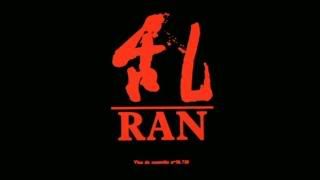
Kurosawa. As directors go there are few that receive more reverence. And rightly so, with a cabal of films that defined action cinema for decades, including such classics as Rashomon, The Seven Samurai and Yojimbo. Incredibly prolific throughout the 50s and 60s, in the twilight of his career Kurosawa sadly had more difficulty finding financing for his projects. Always a perfectionist, the director was more and more unwilling to compromise his epic vision, which meant that his film Ran was in development for a decade before it was finally brought to the screen. Dealing with failing health (and eyesight) and the untimely death of his wife, the director still managed to create a beautiful and heartfelt Shakespeare adaptation which touched on some of his favorite subjects - honor, loyalty and revenge.
The plot follows King Lear rather faithfully in parts, while diverging in some key details. After a rattling dream, Lord Hidetora decides to bestow his kingdom to his three sons - Taro, Jiro and Saburo. While Taro and Jiro accept their new positions with glee, Saburo warns his father that the unity of their family will not remain strong. Angered, Hidetora banishes Saburo. Soon, Saburo's predictions come to pass, as Hidetora is abandoned by his sons who eventually even try to murder him and his men when they take refuge in the kingdom's third castle. Stripped of his family and title, Hidetora is brought to the brink of madness as his keepers try and find Saburo to help regain the family throne.
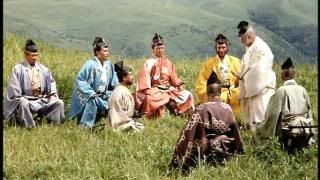
Kurosawa was no stranger to Shakespeare and Shakespearean themes going into the production of Ran, having translated both Macbeth (Throne of Blood) and Hamlet (The Bad Sleep Well) previously. Transplanting these works into Feudal Japan wasn't particularly unique, especially considering Kurosawa's own work The Seven Samurai was adapted into The Magnificent Seven, proving that these stories were strong enough to endure many levels of interpretation. However, despite the Elizabethan origins, Ran feels entirely like Kurosawa working at his peak. Huge battle scenes, breath-taking photography, and an attention to detail that borders on obsessive.
The film's centerpiece (literally) is the attack and burning of the Third Castle which required the construction of an actual building on the slopes of Mount Fuji. The fire raining down on Hidetora as he descends the steps is all very real, and Kurosawa directs the scene with a master's touch. Even in the age where computer effects make even the most fantastical things possible, it doesn't take knowing what you're seeing is real to be impressed.
This scope of action carries onto the battle scenes, where Kurosawa makes his 1400 extras look like ten times that many. The colorful costumes mark each soldier's designation, making things much easier to follow when the soldiers begin to clash. And Kurosawa doesn't shy from the horrors of war, with the bloodshed being both graphic and plentiful. He leaves his most strikingly violent image, however, for a memorable decapitation scene near the end of the film.
Part of what makes Ran so rewarding to watch is the level of character development afforded to secondary characters. Lady Kaede (played with sometimes shocking passion by Mieko Harada) is not merely playing a variation on Lady Macbeth, but is also setting her own plans of revenge into motion. Kyoami is not just a jester, but also comments on the action while showing frustration at his station and having to care for Hidetora out of loyalty. He also brings such much needed comic relief to material that sometimes edges towards melodrama. But it's Tatsuya Nakadai as Lord Hidetora who is really the star here, bringing an otherworldly quality to the anguish his character through reflected by the dramatic (and intentionally obvious) make-up changes his character goes through. While some have pondered what Toshiro Mifune may have brought to the role, Nakadai pours himself totally into the performance and he's excellent here. It's difficult to not see Kurosawa himself reflected in the character of Hidetora, abandoned by his children and being haunted by the actions of his past.
I viewed the Masterworks Edition of Ran released by Fox Lorder after some negative response to their initial DVD of the film. I should mention that there has also been a Criterion release of Ran that would likely be the definitive release up to this point. Video quality is good, preserving the carefully constructed 1:85 ratio compositions (though the image appears slightly cropped and sometimes soft) and containing a great deal of detail. There is a short feature on the DVD dealing with the restoration of the image, comparing it to previous versions, and the difference is dramatic. The soundtrack by Tôru Takemitsu is outstanding, forgoing the bombast of usual epic soundtracks for a more contemplative and eerie score.
The DVD includes the film's trailer, but the real treat is a pair of commentaries, each focusing on a different aspect of production. The first by Stephen Prince is a real treat, exploring the thematic concerns of the film, the similarities and differences from King Lear, and other fascinating (though, often rather scholarly) points. It remains screen specific, and packs an incredible amount of information into the running time. The second commentary is by Peter Grilli who gives a much more anecdotal commentary, speaking about his experiences with Kurosawa and being on the set of Ran during filming. While plagued by long gaps, and rarely referring to what is actually occurring onscreen, it remains a terrific counterpoint to Prince's commentary. We also get a couple of trailers and the restoration video.
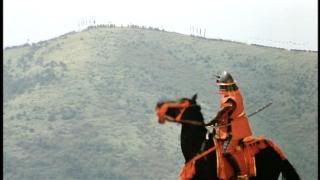
Akira Kurosawa's final masterpiece, Ran is a beautiful film which ended up benefitting greatly from its extended development time. Despite the epic 160 minute run time, there is hardly a wasted frame or line of dialogue in the film and when the battle begins to rage in the final half hour, the groundwork has been adequately laid for the tragic and dramatic ending.

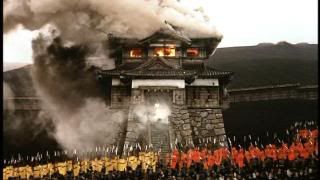

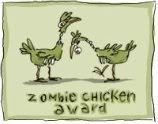








4 comments:
A great movie. Watching it for the first time compelled me to buy the Criterion disc. The Third Castle burning is so beautifully stark and made even more powerful by knowing that it was a real building going up in ashes, with hundreds of extras surrounding it.
I'm going to try to squeeze in "Throne of Blood" before October. I love almost any movie that's Macbeth-influenced.
Nice review. I saw Ran when it premiered in America at the New York Film Festival at Lincoln Center. The audience applauded at Mieko Harada threatening to sever the poor guy's jugular vein (before she gets her own jugular messily severed). When Kurosawa came out to acknowledge the applause, I was surprised to see how tall he was. The audience gave him a standing ovation. A nice memory.
I have put your site on my blog roll. I just posted a couple of entries on Ozu's Early Summer. Though my site is somewhat different from yours, I hope you enjoy it.
http://cinegems.blogspot.com/
Personally I can't see Mifune in this role. Nakadai was just perfect for it. Now, supposedly (and I'm sure you know this) Shintaro Katsu was supposed to play the lead role in KAGEMUSHA--even as a big Nakadai fan, I'd have loved to see that.
I'd have to revisit RAN, but for me it just doesn't stand up to Kurosawa's earlier films. Maybe it's just that the fool bothers me.
The fool is certainly a carryover from Shakespeare (according to the commentary, there really is no equivalent position for a "Great Lord"), but I think once Hidetora loses it after the fire, the role is good at showing the levels of frustration that loyalty can lead to.
I love Katsu and his ability to play both stoic and zany, but I wonder how well he would be able to disappear into a role like that. Still, I would have loved to have seen it.
Post a Comment